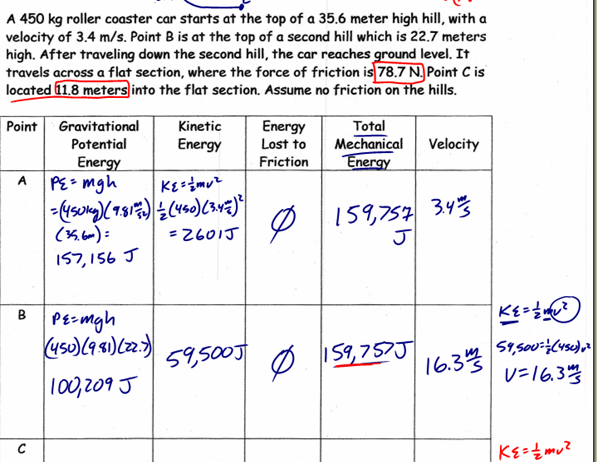Conservation of mechanical energy is a fundamental principle in physics, which asserts that the total mechanical energy of an isolated system remains constant, provided that no external work is done on it. This encompasses potential energy, kinetic energy, and sometimes, the subtle yet impactful element of friction. To understand the intricate relationship between friction and the conservation of mechanical energy, it is essential to unravel the underlying dynamics of energy transformation and the inevitable conflicts that arise therein—a tug-of-war, if you will, between different forms of energy.
At its core, mechanical energy is composed of two primary forms: kinetic energy (the energy of motion) and potential energy (the stored energy based on an object’s position). When we consider a simple scenario such as a roller coaster, potential energy is maximized at the peak of the ride. As the coaster descends, this potential energy is converted into kinetic energy. In an ideal world devoid of any resistive forces, the total mechanical energy of the system would remain constant throughout the ride.
However, reality introduces friction into this equation. Friction, an omnipresent force that opposes motion, plays a pivotal role in the conservation of mechanical energy. As the coaster accelerates down the tracks, friction between the wheels and the rails does not merely sit idly; it dissipates energy in the form of heat. This is where the fascinating interplay between energy conservation and dissipation emerges, as friction can lead to a decline in the system’s mechanical energy.
Understanding friction involves delving into its types. There’s static friction, which prevents objects from moving while they are at rest, and kinetic friction, which comes into play once an object is in motion. Both types of friction contribute to energy loss, yet kinetic friction tends to be more relevant in many mechanical systems, including those we encounter daily—from vehicles to amusement park rides. The differential between potential and kinetic energy illustrates how energy transforms through friction, often resulting in decreased mechanical energy in practical applications.
Imagine a scenario where a sled glides down a snowy hill. Initially, it possesses considerable potential energy, which seamlessly converts into kinetic energy as it descends. However, as the sled encounters the microscopic bumps and textures of the snow, kinetic friction surfaces, sapping away energy that otherwise would fuel an increase in speed. This is the essence of the energy tug-of-war where friction acts as the antagonist to the desire for unimpeded motion.
While friction is often regarded as a hindrance in the pursuit of mechanical efficiency, it also plays a critical role in various practical applications. For instance, in the design of braking systems, friction is harnessed purposefully to convert kinetic energy into thermal energy, thereby stopping the vehicle. Here, the confrontational nature of friction becomes an ally in enhancing safety and control, transforming what could be perceived as energy loss into beneficial functionality.
Moreover, this intersection of friction and energy conservation propels us into the field of engineering, wherein reducing friction becomes a paramount concern. Innovations such as lubricants, streamlined designs, and advanced materials come forth not just to enhance performance but to augment energy efficiency—a shift that can reverberate through entire industries. For example, electric vehicles heavily capitalize on minimizing friction to optimize battery life and extend driving range, aligning technological progress with environmental stewardship. This deliberate engineering fosters a nuanced understanding of friction, transitioning perceptions of it as merely an obstacle to a key variable in optimizing energy use.
Recognizing friction’s dual role in mechanical energy conservation presents compelling implications for the environment. The phenomenon exemplifies the delicate balance in energy systems, emphasizing the necessity of sustainable practices. As the world grapples with climate change, enhancing energy efficiency through the adept management of friction can lead to significant reductions in resource consumption. It beckons an evolution in how we approach design and function across various sectors, compelling a critical examination of energy flow in both natural ecosystems and human-made systems.
Furthermore, this exploration into mechanical energy reminds us of broader ecological interactions. Just as friction dissipates energy in mechanical systems, natural processes similarly encounter resistances that can hinder energy flow. For instance, in ecosystems, factors such as habitat fragmentation create ‘friction’ that impacts biodiversity and energy distribution. A deeper comprehension of these correlations fosters not just scientific curiosity but invites a more integrated perspective on our interactions within larger ecological frameworks.
In conclusion, the relationship between friction and the conservation of mechanical energy is a multifaceted interplay that warrants greater examination. This tug-of-war encapsulates not only the complexities of physical interactions but also inspires innovative solutions to pressing environmental issues. As the dialogue surrounding climate change intensifies, the principles stemming from this investigation can ignite a paradigm shift—one that redefines friction from an obstacle into a catalyst for efficiency and sustainability. Embracing this perspective invites us to be more mindful of the energy narratives we create, empowering us to engage with the environment in transformative ways.







